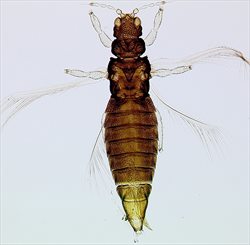
Female (mature)

Teneral female

Antenna
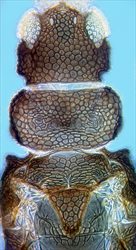
Head & thorax
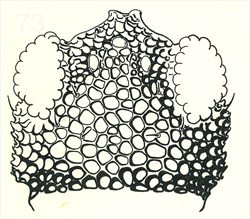
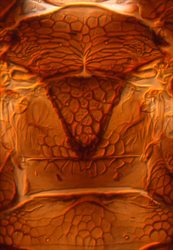
Mesonotum & metanotum
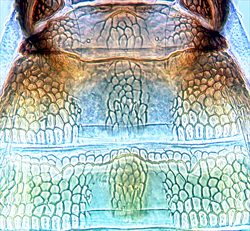
Tergites I-III

Tergites VI-X

Thoracic furcae

Fore wing
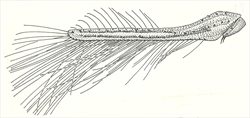
Fore wing
Both sexes fully winged. Body dark brown with legs yellow, but abdomen golden in freshly emerged adults; antennal segments III–V & VII–VIII yellow, VI variably brown; fore wing pale with hind margin and veinal fork shaded. Antennae 8-segmented, segments III & IV each with simple sense cone, VIII slender and at least 3 times as long as VII. Head strongly reticulate, cheeks constricted into basal neck. Pronotum reticulate at anterior and posterior, with no long setae. Metanotum with reticulate triangle projecting over metascutellum, median setae small and arise on anterior half of sclerite; metathoracic furca transverse. Tarsi 1-segmented. Fore wing with apex rounded bearing long cilia; costa with widely spaced long cilia, posteromarginal cilia not wavy; veinal setae scarcely larger than microtrichia. Abdominal tergites strongly reticulate on lateral thirds; tergite I median minute setal pair arising anterior to reticulate area; II–VIII median setae long and close together; VIII with long postero-marginal comb of microtrichia; tergite X short with complete median division. Sternites with three pairs of small marginal setae.
Male very rare, except in Peru (Mound, 1976b).
Three species are now recognised in Heliothrips all originally from South America (Nakahara et al., 2016), but with haemorrhoidalis now widespread around the world. A further species, from South Africa, is now placed in a separate genus, Neoheliothrips.
Larvae, adults and pupae live on the lower surface of the leaves of a very wide range of trees and shrubs, including tea, Pinus and various ferns, but rarely on herbaceous plants or on plants with soft leaves (Scott-Brown & Simmonds, 2006). Large populations are particularly common on plants that are water-stressed.
Originally from South America, probably Peru (Mound, 1976b), the Greenhouse Thrips can potentially be found under glass almost anywhere in the British Isles, though usually in heated houses. However, it has recently been recorded out of doors in the Isles of Scilly and also in London (Robinson & Collins, 2005). It is widespread around the world in the tropics and subtropics, but is also well known in temperate parts of the world as a minor pest particularly of decorative shrubs under glass.
THRIPIDAE - PANCHAETOTHRIPINAE
Heliothrips haemorrhoidalis (Bouché)
Thrips haemorrhoidalis Bouché, 1833: 42
Heliothrips adonidum Haliday, 1836: 443
Heliothrips haemorrhoidalis var. abdominalis Reuter, 1891: 165
Heliothrips haemorrhoidalis var. ceylonicus Schmutz, 1913: 992
Heliothrips haemorrhoidalis angustior Priesner, 1923: 89
Heliothrips semiraureus Girault, 1928: 1
Dinurothrips rufiventris Girault, 1929: 1
Mound LA (1976b) The identity of the greenhouse thrips Heliothrips haemorrhoidalis (Bouché) (Thysanoptera) and the taxonomic significance of spanandric males. Bulletin of Entomological Research 66: 179–180.
Nakahara S, O’Donnell CA & Mound LA (2016) Heliothrips haemorrhoidalis and its relatives, with one new species and one new genus (Thysanoptera). Zootaxa 4021 (4): 578–584.
Robinson J & Collins DW (2005) Two records of Heliothrips haemorrhoidalis (Bouché) (Thysanoptera, Thripidae) breeding outdoors, at Kew Gardens and in the Scilly Isles. Entomologist’s Monthly Magazine 141: 67–68.
Scott-Brown AS & Simmonds MJS (2006) Leaf morphology of hosts and nonhosts of the thrips Heliothrips haemorrhoidalis (Bouché). Botanical Journal of the Linnean Society 152: 109–130.